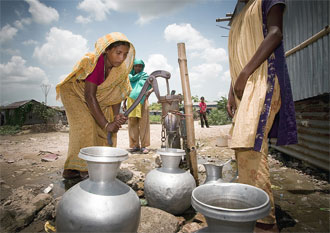Health and the urban environment: revolutions revisited
From cholera pandemics to smog episodes, urban development driven by narrow economic interests has shown itself to be a serious threat to human health and wellbeing. Past revolutions in sanitation and pollution control demonstrate that social movements and governance reforms can transform an urban health penalty into a health advantage. But many environmental problems have been displaced over time and space, and never truly resolved. Health concerns need once again to drive an environmental agenda – but this time it must be sustainable over the long haul, and globally equitable. With the global economic crisis raising the ante, what’s needed is no less than a revolution in environmental justice that puts health, not economics, at the core of its values.
Revolutions in public health
For much of the 19th century, deteriorating environmental health conditions accompanied urbanisation and economic growth. In England, where economic growth was most rapid, there is evidence that urban mortality rates rose – until people acted in a concerted fashion to improve urban living and working conditions. A sanitary revolution was at the centre of the ensuing transformation. By the end of the century urban affluence had become a means to improve public health, at least locally.
Unfortunately, the sanitary revolution did little to prevent pollution of the ambient environment. Sewers released human waste into waterways, contaminating the water for downstream users. Better chimneys improved indoor air quality, but allowed more extensive ambient air pollution. The sanitary revolution was also limited to relatively affluent parts of the world. There are more people without adequate sanitation in the world today than there were at the start of the sanitary revolution.
In the 20th century, there was a pollution revolution – again centred on health in the wealthier world. Many place the turning point of this environmental revolution at London’s Great Smog of 1952, the start of an extended air pollution episode that killed an estimated 12,000 people in one of the world’s wealthiest cities. The response stimulated the birth of modern epidemiology. Just as important, health became central to environmental legislation, and in many countries it remains so to this day.
Unfortunately, just as the sanitary revolution failed to address ambient pollution, the pollution revolution did not address the global environmental burdens of economic growth and urbanisation. Climate change, coupled with recent food and oil price volatility, heralds a new global crisis, demanding a sustainability revolution.
An optimist views the success of the past revolutions as evidence that the sustainability revolution will be relatively unproblematic, and perhaps even result from economic growth itself. For the pessimist, however, the revolutions of the past are illusory: affluence and sanitary and pollution controls merely helped to shift environmental burdens along over time and space – from localised burdens addressed by sanitary reforms, to regional burdens addressed by pollution reforms, to global burdens that epitomise the new sustainability challenge. Since there is nowhere left to shift global burdens to, this kind of displacement is no longer an option. Moreover, since “development” has been highly uneven, a large share of the world’s most deprived urban dwellers now live in unsanitary conditions, threatened by urban pollution and, increasingly, by climate change.
The truth probably lies somewhere between the optimist’s and pessimist’s views. A new revolution is needed, but while there are lessons to learn from the past, more of the same just won’t do. Indeed, environmental sustainability is not enough. A fairer distribution of environmental risks is also needed within the current generation. In short, what is needed is a revolution in environmental justice, across to future generations, but also in the present.
Health and environmental justice
Given the predominance of economic thinking in modern politics, it is tempting to assess sustainability and environmental justice in economic terms. Policy researchers are forever being told that the best way to get the ear of government is to translate their concerns into dollars and cents. The highly influential Stern Review on the Economics of Climate Change would seem to be a case to point. When it comes to open political debate, however, a health perspective is preferable on at least two counts.
First, economic valuation is a fundamentally flawed means of assessing environmental injustices. Secondly, and just as important, while health injustices may be difficult to assess with any precision, health has already shown itself to be a potent force in motivating constructive social action. Cost-benefit ratios are not.
Economic valuation relies on prices set by markets, or prices that markets would set if they were functioning well. The environmental challenges lie precisely in those areas where market prices, and even prices based on the logic of markets, are misleading. Environmental injustices, as well as market prices, reflect the fact that markets distribute wealth too unevenly, discount the future too heavily, and ignore environmental impacts that circumvent market negotiations. Looking to economic valuation to assess these market failures can be self-defeating.
A memo leaked from the World Bank in the early 1990s stated that “the economic logic behind dumping a load of toxic waste in the lowest wage country is impeccable”. It caused quite a stir. Larry Summers, currently Director of the US National Economic Council, undoubtedly regretted having signed it. But the real problem is that the offending statements were all too accurate a representation of conventional economic thinking. The logic is essentially that the health and safety of people on low wages are worth less because the market values them less – just as the market values their labour and belongings less. Most people, including economists, find this notion immoral, but the logic is implicit in most economic valuation, and guides important policy decisions.
Used well, economic valuation can force decision makers to face up to unfair realities. Overused, it can easily reinforce and even create those realities.
When it comes to identifying and addressing the most critical injustices, health provides an important counterpoint. From a health perspective, it is hard to justify shipping toxic waste to low-wage countries. It would still be possible to argue that the toxic waste trade has a positive net effect on receiving countries by increasing their income, but the many debatable assumptions implicit in such arguments would have to be made explicit, rather than being implicit in the valuation system. Similarly, from a health perspective it would be difficult to justify burdening future generations with life-threatening climate hazards for the sake of greater consumption in affluent countries today.
The economic crisis as a hinge event
Just as global environmental burdens are beginning to bite, we are also experiencing the first truly global economic crisis. This is unlikely to be coincidental, and we may well be looking forward to more global economic crises triggered by environmental stresses and scarcities. Currently, the economic crisis creates some serious obstacles to a new public health movement, but also creates vital opportunities.
The obstacles are already evident. Concern about the economy now largely dominates public discourse, and poverty is on the rise. The opportunities are more subtle. They reflect the fact that the crisis is forcing some serious rethinking of global institutions and has wrong-footed those who unthinkingly claim that the market always knows best. An economic crisis can easily become a hinge event, and what emerges is far from predetermined.
Economic crisis was central to the Austrian economist Joseph Schumpeter’s theory of capitalism’s “creative Destruction” and reinvigoration, and to Karl Marx’s theory of its demise. Whatever is to happen to global capitalism – and in the short term, muddling through is more than a remote possibility – this is an absolutely critical time to shift health to the centre of global debate, not to strengthen the health sector, but to improve health globally, now and into the future.
Next steps
Health concerns need to drive a new urban agenda for the 21st century as they did for the 19th-century sanitary movement, and the 20th-century environmental movement.
Health can provide core values for environmental and social justice, while economics cannot.
The ongoing economic crisis is raising the ante, making it far more important to create a new environmental health movement.
About the author – Gordon McGranahan is director of the Human Settlements group at the International Institute for Environment and Development (IIED).
Source – http://environmentalresearchweb.org/cws/article/opinion/39064
 Answering a call of nature in Nairobi’s Central Business has always been a nightmare but it is no longer a scary business
Answering a call of nature in Nairobi’s Central Business has always been a nightmare but it is no longer a scary business 




